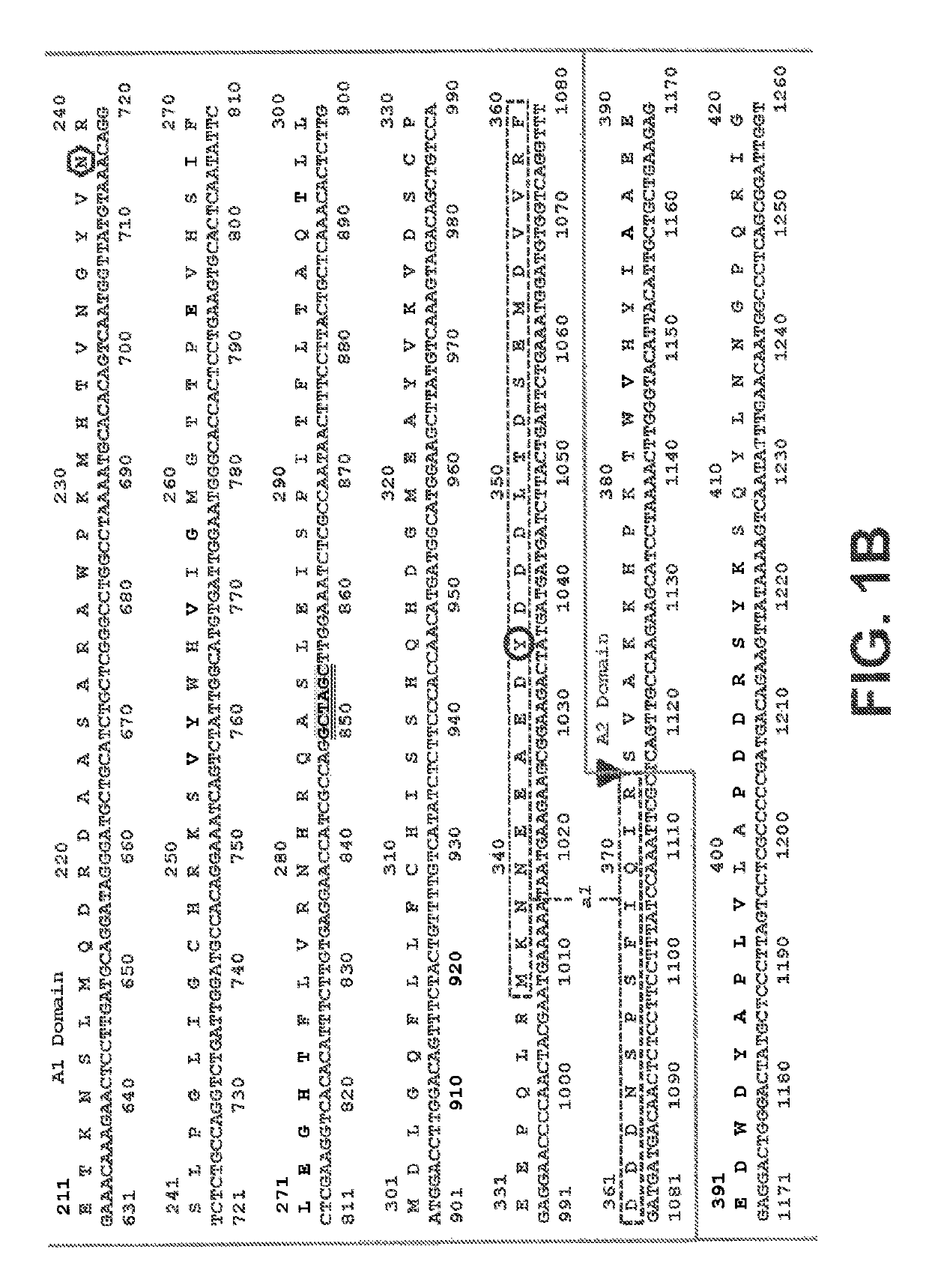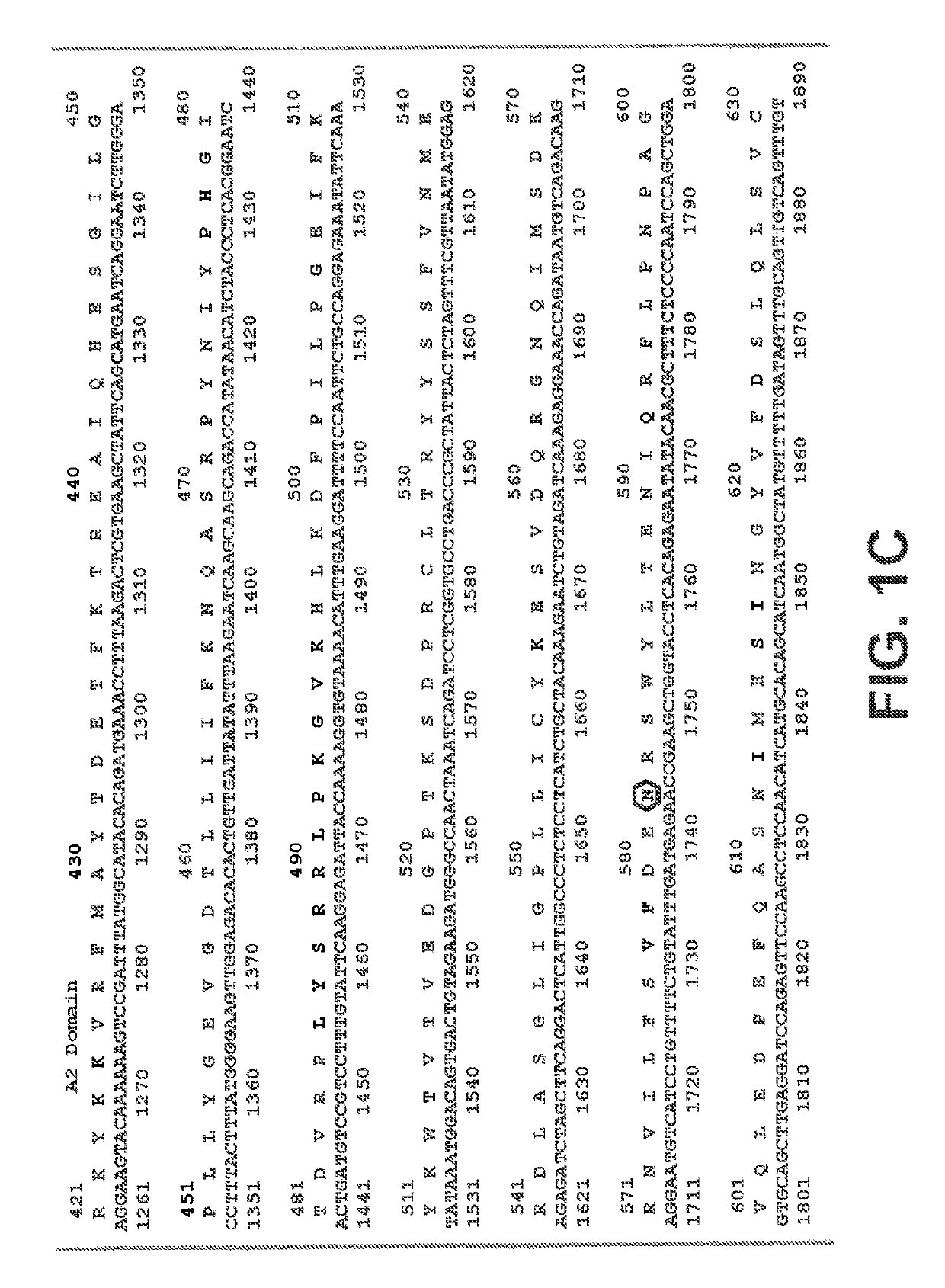Recombinant factor VIII proteins
a recombinant factor and protein technology, applied in the field of bleeding disorder, can solve the problems of hemophilic arthropathy and irreversible joint damage, inability to carry out extensive medical monitoring, so as to and increase the expression of a recombinant fviii protein
- Summary
- Abstract
- Description
- Claims
- Application Information
AI Technical Summary
Benefits of technology
Problems solved by technology
Method used
Image
Examples
example 1
ion and Manipulation of Factor VIII Base Vector, Cloning, Transfection and Expression
[0244]In general, the practice of the present invention employs, unless otherwise indicated, conventional techniques of chemistry, biophysics, molecular biology, recombinant DNA technology, and standard techniques in electrophoresis. See, e.g., Sambrook, Fritsch and Maniatis, Molecular Cloning: Cold Spring Harbor Laboratory Press (1989). The coding sequence of human Factor VIII (Genbank Accession Number NM_000132), including its native signal sequence, was obtained by reverse transcription-polymerase chain reactions (RT-PCR) from human liver polyA RNA. Due to the large size of FVIII, the coding sequence was obtained in several sections from separate RT-PCR reactions, and assembled through a series of PCR reactions, restriction digests and ligations into an intermediate cloning vector containing a B domain deleted (BDD) FVIII coding region with a fusion of serine 743 (S743) to glutamine 1638 (Q1638),...
example 2a
Permissive Loop Site Selection—Method 1
[0248]Biocomputational methods were used to predict the location of specific sites in Factor VIII wherein the insertion of a heterologous moiety would not result in the loss of procoagulant activity. Structural analyses were performed on X-ray crystallographic coordinates 3CDZ (Ngo et al., Structure 16: 597-606 (2008)) and 2R7E (Shen et al., Blood 111:1240-1247 (2008)) deposited in the Protein Data Bank maintained by the Research Collaboratory for Structural Bioinformatics (RCSB; www.rcsb.org / pdb), as well as on atomic coordinates PM0076106 for the predicted refined FVIII structure derived from a molecular dynamics simulation study (Venkateswarlu, BMC Struct. Biol. 10:7 (2010)) deposited in the Protein Model Database (mi.caspur.it / PMDB / main.php) maintained by Consorzio Interuniversitario per le Applicazioni di Supercalcolo per Università e Riserca (CASPUR) and the Department of Biochemical Sciences of the University of Rome.
[0249]The accessible...
example 2b
Permissive Loop Site Selection—Method 2
[0254]Computational methods were used to predict the location of specific sites in Factor VIII wherein the insertion of a heterologous moiety would not result in the loss of procoagulant activity. First, sequence analyses of Factor VIII across different species were carried out using the Basic Local Alignment Search Tool (BLAST; blast.ncbi.nlm.nih.gov / Blast.cgi). A total of 18 FVIII polypeptide sequences from ten different vertebrate species were selected for variation analysis. The species used were human (Homo sapiens) (gi:31499, emb:CAA25619.1, SEQ ID NO:63; gi:182803, gb:AAA52484.1, SEQ ID NO:64; gi:182383, gb:AAA52420.1, SEQ ID NO:65; gi:119593053, gb:EAW72647.1, SEQ ID NO:78), chimpanzee (Pan troglodytes) (gi:332862036, ref:XP_003317837.1, SEQ ID NO:65), gibbon (Nomascus leucogenys) (gi:332260614, ref:XP_003279379.1, SEQ ID NO:66), rabbit (Oryctolagus cuniculus) (gi:284005234, ref:NP_001164742.1, SEQ ID NO:69), dog (Canis lupus familiaris...
PUM
 Login to View More
Login to View More Abstract
Description
Claims
Application Information
 Login to View More
Login to View More - R&D
- Intellectual Property
- Life Sciences
- Materials
- Tech Scout
- Unparalleled Data Quality
- Higher Quality Content
- 60% Fewer Hallucinations
Browse by: Latest US Patents, China's latest patents, Technical Efficacy Thesaurus, Application Domain, Technology Topic, Popular Technical Reports.
© 2025 PatSnap. All rights reserved.Legal|Privacy policy|Modern Slavery Act Transparency Statement|Sitemap|About US| Contact US: help@patsnap.com



